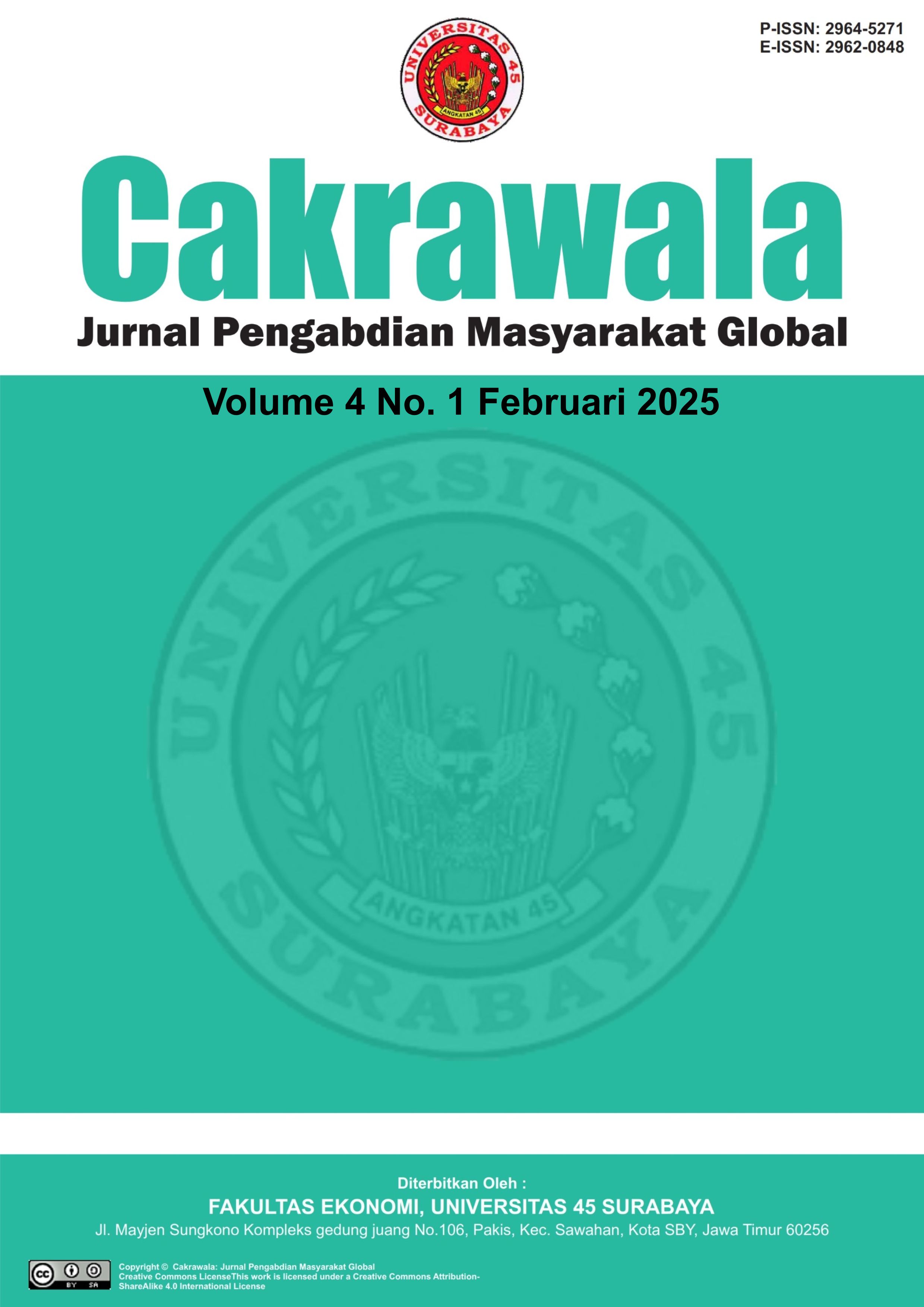Sosialisasi Penerapan Rekam Medis Elektronik sebagai Upaya Peningkatan Kesiapan Kompetensi Digital Mahasiswa Kesehatan pada Praktik Klinik
Socialization of Electronic Medical Record Implementation as a Strategy to Enhance Digital Competency among Health Students during Clinical Practice
DOI:
https://doi.org/10.30640/cakrawala.v4i1.3704Keywords:
Socialization, Record, Medical, Electronic, RMEAbstract
Electronic Medical Records (EMR) is an important health information system for improving efficiency and service quality. In Indonesia, the implementation of EMR still faces challenges such as the lack of readiness and understanding of EMR among healthcare professionals, including students, resulting in considerable resistance to EMR adoption. The EMR socialization activities at the Faculty of Health, Universitas Jenderal Achmad Yani Yogyakarta, aim to enhance students' understanding of EMR and address implementation challenges. These activities involve 22 students from the Medical Records and Health Information (D-3), Nursing (S-1), and Pharmacy (S-1) programs. The socialization material was delivered through interactive approach and discussions, followed by a post-test using the Technology Readiness Index (TRI) questionnaire. The EMR socialization was successfully introducing the basic concepts of EMR to students. Before the socialization, most students were not familiar with EMR and were still using manual medical records. After the socialization, there was a positive readiness for EMR, reflected in students' positive views on the efficiency, effectiveness, and creativity of working with EMR. Continuous capacity-building activities related to EMR for students are necessary.
References
Berihun, B., Atnafu, D. D., & Sitotaw, G. (2020). Willingness to use electronic medical record (EMR) system in healthcare facilities of Bahir Dar City, Northwest Ethiopia. BioMed Research International, 2020, 3827328. https://doi.org/10.1155/2020/3827328
Faida, E. W. (2019). Analisis kesiapan rekam medik elektronik dengan metode Technology Readiness Index Rumah Sakit Universitas Airlangga Surabaya. Jurnal Kesehatan, 7(3).
Hersary, P. A., Raharjo, U. D., & Markus, S. N. (2023). Evaluasi kesiapan mahasiswa program studi. Universitas Jenderal Achmad Yani Yogyakarta.
Irwin, P., Hanson, M., McDonald, S., Noble, D., & Mollart, L. (2024). Nursing students’ perspectives on being work-ready with electronic medical records: Intersections of rurality and health workforce capacity. Nurse Education in Practice, 103948. https://doi.org/10.1016/j.nepr.2024.103948
Keshta, I., & Odeh, A. (2021). Security and privacy of electronic health records: Concerns and challenges. Egyptian Informatics Journal, 22(2), 177–183. https://doi.org/10.1016/j.eij.2020.07.003
Lander, L., Baxter, S. L., Cochran, G. L., Gali, H. E., Cook, K., Hatch, T., Taylor, R., & Awdishu, L. (2020). Self-perceptions of readiness to use electronic health records among medical students: Survey study. JMIR Medical Education, 6(1), e17585. https://doi.org/10.2196/17585
Mijin, N., Jang, H., Choi, B., & Khongorzul, G. (2019). Attitude toward the use of electronic medical record systems: Exploring moderating effects of self-image. Information Development, 35(1), 67–79.
Noble, D., Norton, C., Rm, R. N., & Rn, A. P. O. B. (2021). Nursing undergraduates’ perception of preparedness using patient electronic medical records in clinical practice. 38(2), 37464.
Nwankwo, B., & Sambo, M. N. (2018). Can training of health care workers improve data management practice in health management information systems: A case study of primary health care facilities in Kaduna State, Nigeria. Pan African Medical Journal, 30, 1–8. https://doi.org/10.11604/pamj.2018.30.289.15802
Oumer, A., Muhye, A., Dagne, I., Ishak, N., Ale, A., & Bekele, A. (2021). Utilization, determinants, and prospects of electronic medical records in Ethiopia. BioMed Research International, 2021, 2230618. https://doi.org/10.1155/2021/2230618
Poulos, J., Zhu, L., & Shah, A. D. (2021). Data gaps in electronic health record (EHR) systems: An audit of problem list completeness during the COVID-19 pandemic. International Journal of Medical Informatics, 150, 104452. https://doi.org/10.1016/j.ijmedinf.2021.104452
Rahal, R. M., Mercer, J., Kuziemsky, C., & Yaya, S. (2021). Factors affecting the mature use of electronic medical records by primary care physicians: A systematic review. BMC Medical Informatics and Decision Making, 21, 1–15.
Rosenbloom, S. T., Smith, J. R. L., Bowen, R., Burns, J., Riplinger, L., & Payne, T. H. (2019). Updating HIPAA for the electronic medical record era. Journal of the American Medical Informatics Association, 26(10), 1115–1119. https://doi.org/10.1093/jamia/ocz090
Samadbeik, M., Fatehi, F., Braunstein, M., Barry, B., Saremian, M., Kalhor, F., & Edirippulige, S. (2020). Education and training on electronic medical records (EMRs) for health care professionals and students: A scoping review. International Journal of Medical Informatics, 142, 104238.
Tadas, S., & Coyle, D. (2020). Barriers to and facilitators of technology in cardiac rehabilitation and self-management: Systematic qualitative grounded theory review. Journal of Medical Internet Research, 22(11), e18025. https://doi.org/10.2196/18025
Wilks, B. (2019). Doctors in training: EMR: Friend or foe? Australian Medicine, 31(22), 24–25.
Yehualashet, D. E., Seboka, B. T., Tesfa, G. A., Demeke, A. D., & Amede, E. S. (2021). Barriers to the adoption of electronic medical record system in Ethiopia: A systematic review. Journal of Multidisciplinary Healthcare, 2597–2603.
Downloads
Published
How to Cite
Issue
Section
License
Copyright (c) 2024 Untoro Dwi Raharjo, Anastasia Suci Sukmawati, Rizky Yuspita Sari, Imaniar Sevtiyani

This work is licensed under a Creative Commons Attribution-ShareAlike 4.0 International License.








